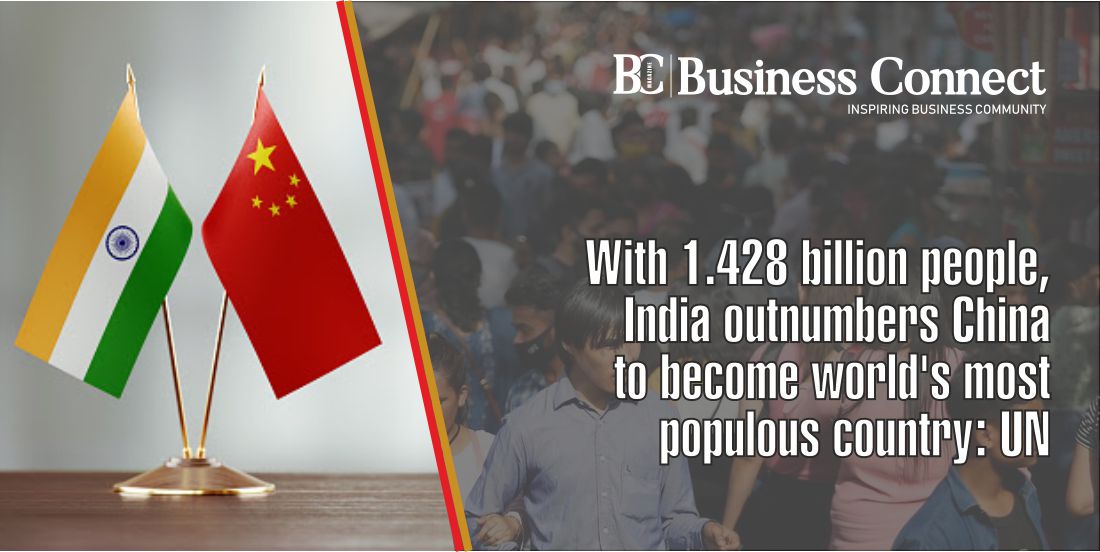With 1.428 billion people, India outnumbers China to become world’s most populous country: UN
According to UN figures released on Wednesday, India has surpassed China as the world’s most populated country. India now has a population of over 1.428 billion, only a little bit more than China’s 1.425 billion, according to the UN’s World Population Dashboard.
According to a recent UNFPA study, 25% of Indians are under the age of 14, 18% are between the ages of 10 and 19 and 26% are between 10 and 24. Of them, 68% are between the ages of 15 and 64, and 7% are above 65.
The population of India will increase for roughly three decades until reaching a peak of 165 crore, at which time it will start to drop, according to projections from a number of organisations.
With an estimated 340 million people, the United States comes in third place, according to figures from a survey that uses data up to February.
Using earlier data from the UN, population experts predicted that India would exceed China this month, but the most recent report from the international organisation omitted a date.
UN population officials have stated that it is not possible to pinpoint a date due to the ambiguity surrounding the data from China and India. India’s last census was conducted in 2011, and the next, scheduled for 2021, was postponed due to the COVID-19 pandemic in India.
Although both countries will make up more than a third of the projected 8.045 billion world population, population growth in both has been going down, albeit considerably more quickly in China than India.
As the country transitions away from agriculture jobs, the growing population will make it even more urgent for Prime Minister Narendra Modi’s administration to find opportunities for the millions of individuals joining the workforce. India, a nation where 50% of the population is under 30, is expected to be the world’s fastest-growing major economy in the future years.
Asia’s third-largest economy is home to more people than all of Europe, Africa, and the Americas put together. While this is now also true for China, it is anticipated that this will change as India’s population continues to grow and reaches 1.668 billion by 2050, when China’s population declines to roughly 1.317 billion.
But India’s great size and sustained growth also reveal its enormous obstacles, reviving in this most recent spotlight moment a continuous, if still uneasy, question: When will it ever realise its vast promise and become a force comparable to China or the United States?
About 12 million people enter the employment market each year in India, where half of the population is under the age of 30. India’s challenge is to maintain this rate of increase in the upcoming decades in order to avoid experiencing even higher unemployment rates. The country’s growth rate was expected to be 7% in the previous fiscal.
The executive director of the Population Foundation of India, Poonam Muttreja, stated that “the young people have a great potential to contribute to the economy.” But in order for them to achieve that, the nation must spend in health, nutrition, and employable skills in addition to education.
Jobs are also necessary. That has been a long-standing weakness for a top-heavy and occasionally stagnant economy that needs to find a way to create 90 million new jobs outside of agriculture before 2030 in just to maintain employment rates at current levels. India was already lagging behind that pace in the years just before the pandemic
It will be more difficult for China to sustain economic growth and realise its geopolitical ambitions to overtake the United States as a result of its ageing and declining population. But in earlier decades, when it was still expanding, it, like smaller East Asian nations before it, discovered its path to transformational prosperity through export-driven manufacturing.
India hasn’t yet been able to duplicate that formula or develop a unique one that can produce more than just small improvements.
While India touts its demographic dividend, a crucial statistic—women’s employment—is rarely mentioned in the press. barely slightly more than Afghanistan, women make up barely a fifth of the labour force overall. In contrast, 44.8% of workers in China are women.
India’s population is still predominantly rural, unlike China. By 2035, the majority of Indians will still reside in the countryside, whereas the majority of Chinese people would move into cities, according to UN-Habitat’s forecasts. This is despite the fact that workers from both nations are moving to megacities in search of better opportunities.
That serves as a reminder of the difficulties the nation of South Asia faces in eradicating poverty and lowering inequality.
Must Read:-
- Success Story of Ratan Tata
- Top 10 Schools in Delhi 2021, list of best schools for your child
- Business vs Job: Which is Better
- Top 10 series on Netflix 2021, don’t miss these must-watch series
- Top 10 richest player of the world 2021
- Top 10 highest paid CEO in the World
- Top 10 richest person of India
- Top 10 Highest-Paid CEOs of India
- The Success Story of Steve Jobs
- Top 10 Business Magazine In India
- Top 10 Business Newspaper In India


